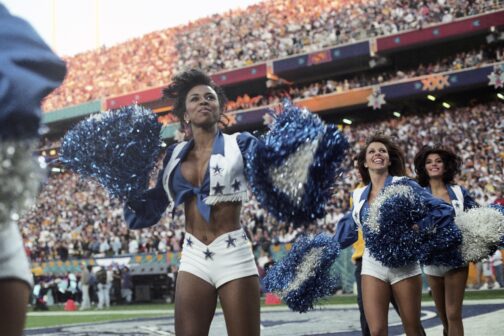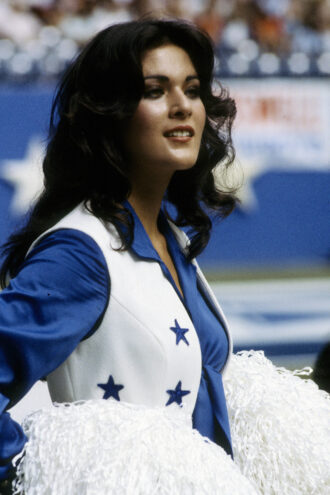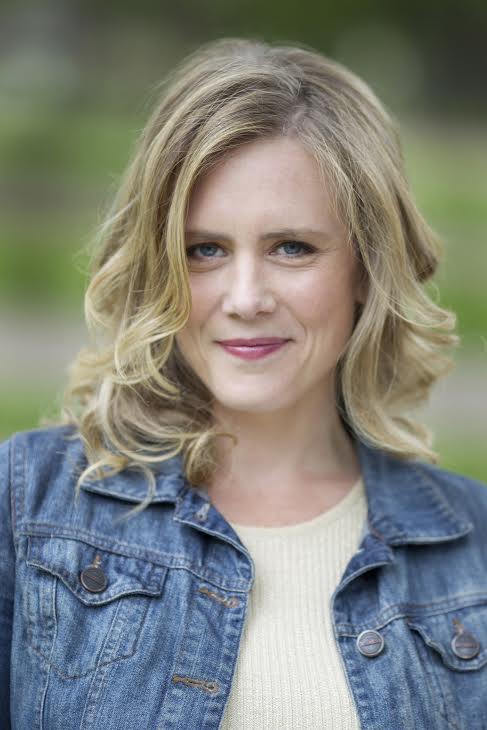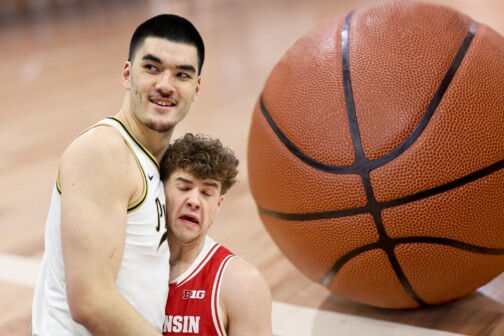For the past month, the journalist and author Sarah Hepola has explored the highlights, pitfalls, scandals, and cultural impact of the Dallas Cowboys Cheerleaders through her Texas Monthly podcast America’s Girls. With each episode dedicated to its own topic—like the iconic uniform and the specific rules the cheerleaders have to follow—America’s Girls does more than serve as a timeline; it also uncovers some crucial history lost to time.
In the fourth episode, titled “The Uniform,” Hepola interviews two women who both claim to have designed that iconic uniform — Dee Brock, the woman who started the Dallas Cowboys Cheerleaders, and Paula Van Wagoner, a fashion designer. As the podcast ends, listeners must decide for themselves which woman they believe. But Hepola offers something else for listeners to chew on. Maybe it matters less who designed the uniform and more why neither of them were paid for it.
“It’s no small thing to be a part of history, but it’s about time history gives them their due,” Hepola says at the end of the episode.
Hepola does just that, speaking to cheerleaders from every decade, asking about their pay, the organization’s problems, and why these women have had a chokehold on America for the last 50 years. She even interviewed me during the seventh episode because of my articles about the cheerleaders.
Recently, Sarah and I caught up over the phone to talk all about the women we can’t get enough of. It has been edited for length and clarity.

D: This was one of the first questions you asked when you interviewed me for the podcast, so I want to ask you: When did you first become aware of the Dallas Cowboys Cheerleaders?
Hepola: My family moved to Dallas in 1978 when I was 4 and it was somewhere in that next year or two that I started seeing the posters everywhere. This was the peak of their pop culture popularity. It was peak Dallas in a lot of ways. Dallas had just hit the air, the Cowboys had just been called America’s Team, and these posters were at 7-Elevens and I have a specific memory of being at a dance studio and looking up and seeing a squad photo.
And then there was this one poster from 1979. It wasn’t the most popular one, which was the 1977 posters, but this 1979 poster had this redhead named Suzette Russell that just … I was obsessed with her. She was so beautiful. I thought she was the most beautiful woman I had ever seen. It had the same feeling as when you see an actress or a model, just this totally alluring vision of glamour that you just get sort of obsessed with.
The Cowboys didn’t want to partake in this podcast. Why do you think that is?
They have made a careful calculation that they had nothing to gain by participating. They’re very protective of their brand and message — especially when it comes to the cheerleaders. They know that there’s a drumbeat out there around issues they don’t want to address, like fair pay, sexual discrimination, racial equality. Access for them is one of the great leveraging points they have. They have access to troves of information, marquee names, and the status of using their name, and they’re not going to give that to somebody that won’t play by their rules. And I think they knew I wasn’t going to.
You say that the Cowboys are so protective of their message, yet the reality show, CMT’s Dallas Cowboys Cheerleaders: Making the Team is so messy. That show has not aged well at all. Is there any irony to that?
The reality show was incredibly canny of them. They were able to give the appearance of full disclosure while carefully maintaining the message that they want to get across. And a lot of those things they were very proud of. These women work very hard. It is tough to make this squad. You have to really, really work and you have to work your body in order to do that. And all of that gets put out in a time when reality TV itself has really doubled down on what we might call the Simon Cowell effect. We’ve got a whole industry trend of amateurs putting themselves into cattle calls where harsh critics can basically torpedo them with a few well-chosen phrases.
And then the other thing that happens is the culture changes. And I don’t think DCC anticipated that. I don’t think anybody did. And the place where it has really hurt them the most is the way they talked about women’s bodies. They had a certain way of critiquing candidates that became deeply unfashionable in a body-positive environment.
How would the podcast be different with a Cowboys voice?
I would have really liked to engage with Charlotte Jones (executive vice president and chief brand officer of the Dallas Cowboys) in particular on the pay issue. She’s probably the person I wish the most had said yes because I think she’s the one who has the power to make that change.
Oh, yeah.
As someone who posts on Instagram about International Women’s Day and the organization touts her as one of the highest slotted women in the NFL, who is arguably poised to take over that team after her father retires, she’s in a plum position to do something that’s never been done in the NFL before: pay cheerleaders a livable wage. The Dallas Cowboys Cheerleaders led the march into this whole phenomenon with uniforms and dancing and innovation and it strikes me as an incredibly cool move to lead a march into a new era where we admit this is a full-time profession, these are valuable entertainers, and they do deserve a livable wage.
Oh, yeah. It would be so easy and such good PR. It seems like such an obvious move.
They’re a $6.9 billion franchise and you’re telling me they can’t do this? I’ve run the math on this and it’s not that hard.
Right, right. At some point, you have to take it at face value and say, OK, you obviously think these women are worth $10 an hour. It took a lawsuit to change the game-day pay, which still isn’t great.
You take 36 cheerleaders, you times it by $50,000 a year and I’m telling you that’s still not as much as Jerry Jones has made in payoffs, like, for instance, after Michael Irvin slit the throat of his teammate and there was a settlement reached to not talk about it.
Speaking of Jerry Jones, there seems to be a rivalry between the cheerleaders who cheered pre-Jerry Jones buying the Cowboys and the cheerleaders-post. It’s explored in episode five. I got a sense of it after going to the premiere of the documentary about DCC, Daughters of the Sexual Revolution. When did you first get a sense of that division?
It’s fascinating, isn’t it?
Yeah.
The first cheerleaders that would speak to me on the record were the ‘70s cheerleaders. They would be a little bit more critical of the organization. They’d say things like, Don’t you think they’re a little bit too sexualized these days? Or, Isn’t it weird that you get a Christmas card and they all look the same even though they have different ethnicities and races? And those were interesting critiques that I had noticed, but it was very interesting coming from the cheerleaders themselves. I wouldn’t want to characterize it as a blanket rivalry because some of the ‘70s cheerleaders I spoke to said (director) Kelli Finglass is amazing and what DCC has done is amazing. I think watching it evolve and continue to dominate has been a point of pride for them. But they were really instilled with certain messages around wholesomeness that I don’t think they necessarily see in the new regime.
You brought up that they all look the same, which leads me to the race aspect of DCC. I’m glad you highlighted how the 2020 season had its most Black women ever, I believe.
Well in 1971, they had fewer cheerleaders but half were Black. But the 2020 season had the most Black women.

Right, right. I also did this research and it was so hard once you get to the 2000s and you’re just eyeing it because the cheerleaders do look the same. The White and Black women look the same because the White women’s tans are so dark, you almost can’t tell the difference.
You’re exactly right and hair extensions entered the culture and so once you get hair extensions, everybody’s hair is that long curly hair and you can’t tell.
So with DCC preferring a White thin woman, do you think that’s reflective of all of Dallas?
I would probably push back on the idea that they prefer a White thin woman because I just don’t know. I would say that White thin women are by far the representative image that they put out. I think it’s reflective of a trademark Dallas look that was cemented in the ‘80s thanks to that peak pop culture Dallas reign of the show Dallas and the team and media and probably cultural obsession with the rich parts of town, like Highland Park or North Dallas or even things that you see, like the Real Housewives.
I do think when people think of Dallas, they see a thin White woman, but Dallas itself, at least the city of Dallas, has become increasingly diverse. It has one of the fastest growing Black populations in the country and, of course, like all of Texas has a large Hispanic population and because of the last few years, you’re seeing that increasingly reflected in the media.
But that was slow to come to Dallas. The representation of its diverse population was slow to come to the pages of the magazines and the newspapers that represent this city. I’m sad to say that, but I think it’s true.
DCC posted a photo the other day of their last six Pro Bowl Cheerleaders and five of them were White women who looked the same. It’s a problem across the NFL.
Can I say one thing?
Yeah!
That’s one of the reasons I really wanted to start the show with Vonceil Baker. Vonceil Baker is the first woman to put on the Dallas Cowboys Cheerleaders uniform and she has the longest tenure on the squad. And she’s a Black woman who grew up in South Dallas as one of five children to a single mom. And she is beautiful. To me, she looks like Diana Ross. But she’s not what people see in their mind when they think of Dallas or the Dallas Cowboys Cheerleaders. We wanted to challenge some of those stereotypes from the beginning of the show.
I thought it was so interesting how (founder) Dee Brock wanted to integrate the cheerleaders so early on and they had more Black women on the squad early on and, like you said, it was a Black woman who first wore the uniform and she’s had the longest tenure on the squad.
Yeah, eight years.
You look back at all of that and it’s like, why are they not progressing? It’s getting more White when the rest of the world isn’t.
It’s so interesting that as America or Texas became more diverse, the cheerleaders themselves became less diverse. And I think we have to be careful about attributing intention or reasons behind that because I think they’re very complicated. I know from talking to some of the women and leaders at that time that they themselves were very frustrated that more Black women weren’t trying out. And there were recruitment efforts made. And right around that time of the ‘80s, ‘90s, aughts, when there’s only two or three or maybe four Black cheerleaders on the squad, I think they knew that was a problem.
But they didn’t know what to do about it and in the public consciousness, the idea of cheerleading as a White girl’s hobby is taking hold. Even in the years when the squad was pretty diverse, they weren’t the poster girls. And the posters are what really cement the image of the cheerleaders in the public’s mind.
The Dallas Cowboys Cheerleaders led the march into this whole phenomenon with uniforms and dancing and innovation and it strikes me as an incredibly cool move to lead a march into a new era where we admit this is a full-time profession, these are valuable entertainers, and they do deserve a livable wage.
Sarah Hepola
You look at who is on the cover of the swimsuit calendars and also, it got harder to make the squad because the dance technique got more intense, and so systemic racism ties into that. Do Black women have the same opportunities to take all the dance classes that the white women do?
Dance classes are expensive and it’s not just expense. It’s also value or cultural norms.
I’ve also had Black NFL cheerleaders tell me that they have a different body shape that DCC may not favor. I do agree it’s a big circle. Are Black women not trying out? Or Do Black women not feel safe trying out? Do they not think that they have a shot at making it?
Right.
There’s always a fear I have when I write about pro cheerleaders — especially DCC, because I love them so much — that if I start to highlight the organization’s problems, I’ll be part of bringing them down. That’s not what I want at all. I want these women to be paid and treated fairly. Did that ever cross your mind that this podcast would put more eyes on their problems?
For sure. But I think if you’re going to hit a cheerleading squad, you hit this one because it’s the one that can take the hits and has the best chance of changing. They are so iconic and you choose the strongest person to make an example out of. And I would be shocked if a podcast that I did for Texas Monthly ended up bringing down the Dallas Cowboys Cheerleaders.
(Laughs.) You never know.
Especially given that that podcast was born out of my wanting to understand and celebrate the history and the contributions of this squad ,not only to the city where I live but the culture that I breathed in for the last 47 years. I think the only thing that would take down that cheerleading squad is a massive scandal of unforeseen proportions. But I can promise you that that fear was on the minds of the people that spoke to me.

Oh, I’m sure.
Because one of the great disincentives for cheerleaders to speak honestly about the complications of their experience is the fear that it will be used as a reason to just make the whole thing go away. And imagine being in this position where in order to speak about this thing that was such a deep part of your life and like all things, obviously complicated and had downsides, but in order to speak about that honestly, you run the risk of making it disappear. Of course they don’t want to speak to a journalist.
What do you think of pro cheerleading now? Have any of your opinions changed? What does its future look like?
When we first sat down for lunch together, I remember you describing the cheerleaders as smart. And I challenged you on that. Because I was like, Paige, they’re beautiful, they’re talented, they’re graceful, but smart? I just don’t get it. And you made the point that they have to pass a test and that’s true, but it’s not just that, it’s like the intelligence that is required to keep all the balls moving that they do, to be one way here and one way there and to not speak out of turn or in a way that would look bad on the organization and to be under the kind of scrutiny and pressure that they are—hell yeah, that requires an intelligence. It may not be the kind of book smarts that an egghead like me has valued over the years, but certainly some of the cheerleaders that I have met have had that as well.
The other thing is that you would often describe them as athletes. And I’m still chewing on this because there’s no question that they have a lot of stamina, grace, control over their body that would mark an athlete, but I see them as performers and I think it’s tricky.
I think they have all the athletic prowess. I still don’t see them as athletes. At the same time, I see that word being used more and more because I think people want to make a corollary between what’s going on on the field and what’s happening on the sidelines. And I can certainly say there’s an athletic toughness to what they do. What it takes to do that is so much more than I ever imagined.
I guess I view them as both — a performer and an athlete. But you’re right. There is a shift going on right now in pro cheerleading where a lot of squads are trying to rebrand themselves as tougher athletes and trying to move away from the sexy image. But where do you think DCC will be in 10 years?
What’s so interesting to me is that professional cheerleading is kind of going back to what it was in the beginning in some ways. In the Dallas Cowboys Cheerleaders case, it was co-ed squads that did stunting that had more modest costumes. That is fascinating and seems to be a train that’s not going to stop. I think the Dallas Cowboys Cheerleaders are a legacy brand now and they run the risk of losing their cachet if they change. I don’t think they want to be seen as somebody that’s going on another trend. I think they want to stake out their own place as trendsetters. It wouldn’t surprise me if in 10 years the rest of the NFL was co-ed and stunting and modest costumes and the Dallas Cowboys Cheerleaders once again, back at the beginning, are the only sexy sideline dancers we see out there in the NFL. And that would maybe increase their status even more because they would be the last ones standing.






